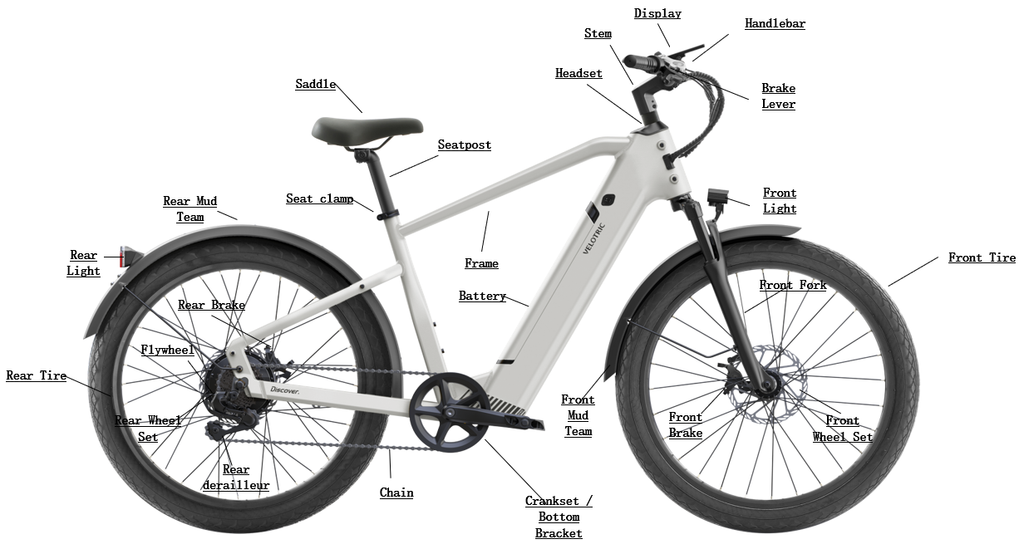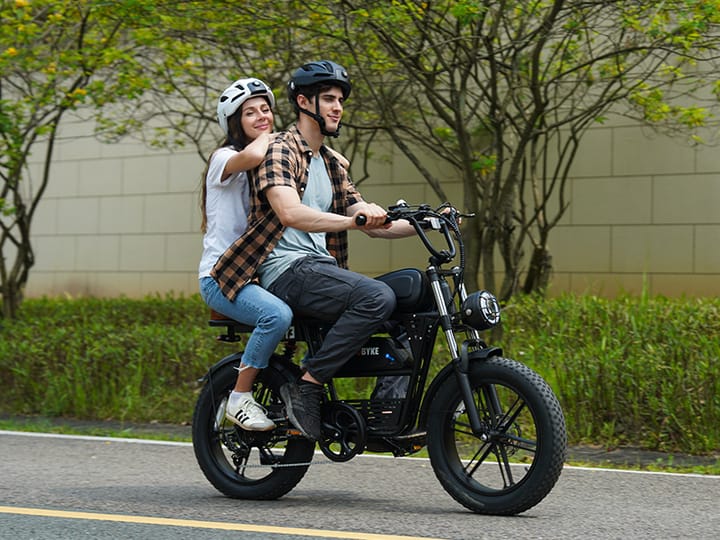Breaking Down the Anatomy of an E-Bike: All the Main Components Explained

Electric bikes are often described as “just a regular bike with a motor,” but if you’ve ever looked closely at one, you’ll see there’s much more going on under the frame.
The beauty of an e-bike is how seamlessly it blends bicycle mechanics with electric power to give you speed, range, and control.
Whether you’re considering buying your first e-bike, maintaining the one you already own, or just curious about how they work, it helps to understand all the main components that make up the machine.
Let’s take a detailed tour of the anatomy of an e-bike.

1. The Frame
At its core, every e-bike starts with the frame.
- Materials: Aluminum is most common (lightweight, durable), but higher-end models may use carbon fiber or steel.
- Designs: Frames come in step-over, step-through (easy mounting), and folding styles. The frame often houses the battery, cables, and sometimes the controller.
- Durability: E-bike frames are built to handle extra weight (battery + motor) and higher riding speeds compared to traditional bikes.
2. The Motor
The motor is the heart of the e-bike, providing the extra push when pedaling. There are three main types:
- Hub Motor: Located in the front or rear wheel hub. Simple, affordable, and low-maintenance. Rear hub motors give more natural traction, while front hubs can feel like you’re being pulled.
- Mid-Drive Motor: Positioned near the pedals at the crankset. More efficient on hills and delivers power through the bike’s gears, giving a smoother ride.
- Friction Drive / Specialty Motors: Less common, these attach externally to the tire or use unique drive methods.
Power ratings: Most motors range from 250W to 750W (legal limits vary by country), with torque measured in Newton-meters (Nm). Higher torque = better climbing ability.
3. The Battery
The battery is the fuel tank of your e-bike.
- Chemistry: Most use lithium-ion cells, the same tech as in laptops or electric cars.
- Capacity: Measured in watt-hours (Wh). A 500Wh battery can deliver 500 watts of power for 1 hour, or 250 watts for 2 hours.
- Mounting: Batteries can be integrated into the frame (sleeker look) or mounted externally (easier to swap).
- Charging: Standard chargers take 3–6 hours to fully recharge.
Battery life depends on terrain, rider weight, assistance level, and weather, but typically lasts 500–1,000 charge cycles.
4. Controller
The controller is the brain of the e-bike. It regulates how much power flows from the battery to the motor, based on your input.
- Functions: Manages pedal assist, throttle response, safety cut-offs, and regenerative braking (on some models).
- Location: Often hidden inside the frame or mounted under the battery pack.
Without the controller, your e-bike is just a heavy bike with a dead weight motor.
5. Pedal Assist System (PAS) & Sensors
Most e-bikes use sensors to detect your pedaling and decide how much motor power to apply.
- Cadence Sensor: Measures if you’re pedaling, then delivers a set level of power. Simple but can feel jerky.
- Torque Sensor: Measures how hard you’re pedaling and matches your effort with proportional motor assistance. Feels smoother and more natural.
- Combined Systems: Some e-bikes use both for better responsiveness.
These systems give you different assist levels (Eco, Normal, Turbo), letting you balance effort and range.
6. Throttle (Optional)
Not all e-bikes have throttles, but many commuter and cargo models do.
- Thumb Throttle: Activated by pushing with your thumb.
- Twist Throttle: Works like a motorcycle grip.
- Purpose: Allows riding without pedaling, useful for quick starts, hills, or when you’re tired.
Some regions restrict throttles for legal reasons, so always check local laws.
7. Display / Control Panel
Mounted on the handlebars, this is your dashboard.
- Basic Models: Show battery level and assist mode.
- Advanced Displays: Add speed, distance, range estimates, navigation, and even smartphone connectivity.
- Controls: Buttons near the grips allow easy switching between assist levels while riding.
8. Drivetrain (Gears & Chain/Belt)
The drivetrain combines traditional bike mechanics with e-power.
- Chain & Derailleur: Common on most e-bikes, offering multiple gears.
- Belt Drive (Carbon Belt): Found on higher-end models; quieter, cleaner, and requires less maintenance.
- Internal Gear Hubs: Protected gearing systems that pair well with mid-drive motors for low-maintenance commuting.
Because e-bikes put more strain on chains and gears, many components are reinforced.
9. Brakes
Stopping power is critical since e-bikes are heavier and faster.
- Mechanical Disc Brakes: Cable-actuated, cheaper, but less powerful.
- Hydraulic Disc Brakes: Stronger, smoother, and require less hand effort.
- Regenerative Braking: Rare outside high-end models, but can recharge the battery slightly.
10. Wheels & Tires
E-bike wheels and tires are built for durability.
- Wheels: Often wider and with stronger spokes to support extra weight.
- Tires: Come in commuter slicks, hybrid all-terrain, or fat-tire options for snow/sand. Many are puncture-resistant.
11. Suspension (Optional)
- Rigid Frame: Lighter and simpler, good for city riders.
- Front Suspension Fork: Smooths out bumps on roads and trails.
- Full Suspension: Rear + front suspension, best for mountain e-bikes.
12. Accessories & Add-Ons
E-bikes often come with extras that make them commuter- or adventure-ready:
- Lights: Often integrated and powered by the main battery.
- Fenders & Racks: For cargo and weather protection.
- Kickstand: Reinforced to hold extra weight.
- GPS & Anti-Theft Systems: Increasingly common on premium models.
Final Thoughts
An e-bike is a finely tuned combination of bicycle mechanics and electric technology.
Every component, from the motor to the sensors works together to give you a ride that’s efficient, powerful, and adaptable to your lifestyle.
Understanding these parts not only helps you choose the right e-bike but also makes you a smarter owner when it comes to maintenance, troubleshooting, and upgrades.
Once you know the anatomy, the machine feels less like magic and more like a clever piece of engineering that puts freedom right at your fingertips.
Thanks for reading! Subscribe for free to receive new posts and support my work.



Comments ()